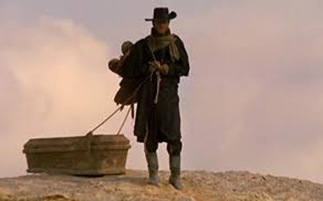1966
Director Sergio Corbucci
Awkward dialogue. Wooden performances. A title role character that has since become a walking, talking cliché. Why is Sergio Corbucci’s Django such a triumph?
walking, talking cliché. Why is Sergio Corbucci’s Django such a triumph?
After saving a young woman from a group of bandits, Django arrives out of the horizon with a mysterious coffin in tow to a town that just happens to be the focal point in an ongoing violent conflict between Mexican outlaws and a group of religious fanatics.
The Western has become an iconic symbol of Hollywood, and the Spaghetti Western is its chiselled extension. Action heroes by the dozen (Han Solo, John McClane etc.) owe a weighty debt to the mythical gunslinger. Django is the archetypal Western, be it pasta-based or just plain ole’ American apple pie. Corbucci captures the miserable, arid beauty of the Old West within a decayed graveyard, the sight of Django’s final stand, a symbolic crumbling field of beauty. The depth of Ford’s The Searchers or True Grit may be gone, replaced by the sight of Major Jackson (Eduardo Fajardo) engaging in a spot of shooting practice over the gorgeously excessive score of Luis Enríquez Bacalov.
The explosions of violence in Django are another simple yet perfectly pitched technique blasted at us by Corbucci to add the bloody cherry to an icing thick with corpses lying prone upon a cake of dirt.
 What Nero brings to his embodiment of the gunfighter is vulnerability. Sure, he drops men by the dozen, but this is a fighter who feels pain. When we first meet him, Django is an expressionless, monosyllabic enigma hidden behind a hat, a beard and a pair of sinister, oceanic blue eyes. But by the end, Nero reduces the myth to a handicapped mess of a man.
What Nero brings to his embodiment of the gunfighter is vulnerability. Sure, he drops men by the dozen, but this is a fighter who feels pain. When we first meet him, Django is an expressionless, monosyllabic enigma hidden behind a hat, a beard and a pair of sinister, oceanic blue eyes. But by the end, Nero reduces the myth to a handicapped mess of a man.
Django is a piece of work that remains as viscerally intense, thematically unpredictable, and musically magnificent as anything fired from the gun of cinema’s most iconic genre since.
**** ¼ / *****
No comments:
Post a Comment